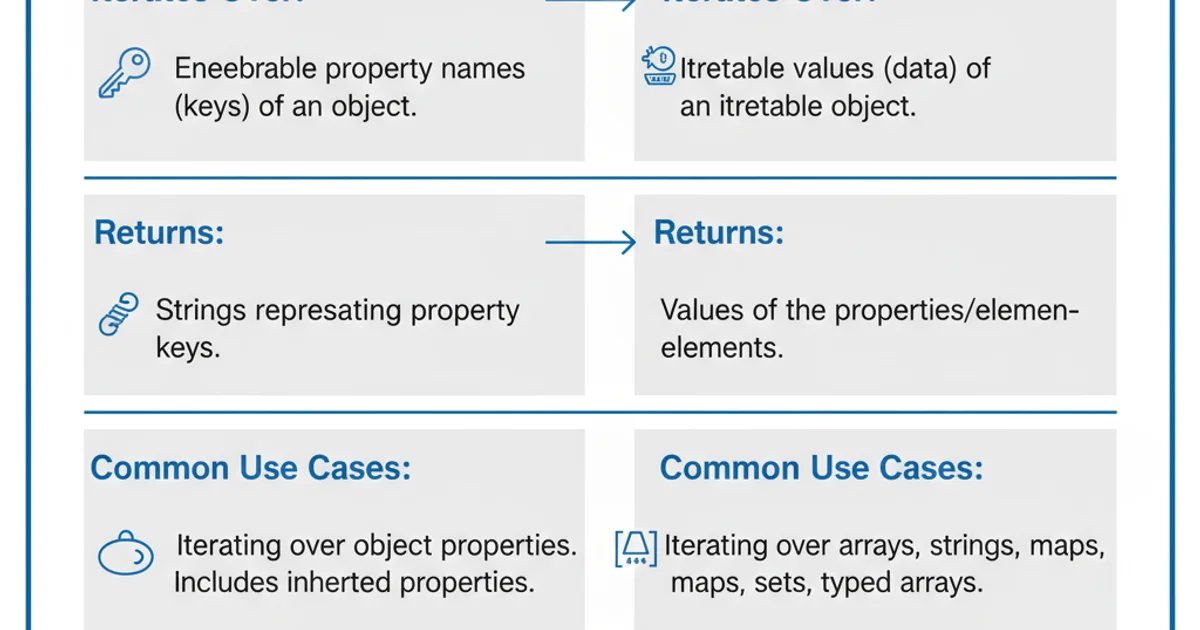Difference between ( for... in ) and ( for... of ) statements?
Categories:
Understanding JavaScript Iteration: for...in vs. for...of

Explore the key differences between JavaScript's for...in and for...of loops, their use cases, and how to choose the right one for iterating over objects and iterables.
JavaScript provides several ways to iterate over data structures. Among the most common are the for...in and for...of statements. While both are used for iteration, they serve fundamentally different purposes and operate on different types of data. Understanding their distinctions is crucial for writing efficient and bug-free JavaScript code. This article will delve into each loop, illustrating their behavior with examples and providing guidance on when to use which.
The for...in Loop: Iterating Over Object Properties
The for...in loop is designed to iterate over the enumerable string properties of an object, including inherited enumerable properties. It returns the keys (property names) of the object, not the values. This makes it particularly useful for inspecting object structures or iterating through key-value pairs in plain JavaScript objects.
const myObject = {
a: 1,
b: 2,
c: 3
};
for (const key in myObject) {
console.log(`Key: ${key}, Value: ${myObject[key]}`);
}
// Output:
// Key: a, Value: 1
// Key: b, Value: 2
// Key: c, Value: 3
Using for...in to iterate over object properties.
for...in with arrays, it iterates over the index strings (e.g., "0", "1", "2") and any other enumerable properties, including those inherited from the prototype chain. This can lead to unexpected behavior and is generally not recommended for iterating over array elements. Always use hasOwnProperty() to filter out inherited properties if you must use for...in on objects.const myArray = [10, 20, 30];
myArray.customProperty = 'hello';
for (const index in myArray) {
console.log(`Index: ${index}, Value: ${myArray[index]}`);
}
// Output:
// Index: 0, Value: 10
// Index: 1, Value: 20
// Index: 2, Value: 30
// Index: customProperty, Value: hello
// Corrected usage with hasOwnProperty()
for (const index in myArray) {
if (myArray.hasOwnProperty(index)) {
console.log(`Index: ${index}, Value: ${myArray[index]}`);
}
}
// Output:
// Index: 0, Value: 10
// Index: 1, Value: 20
// Index: 2, Value: 30
// Index: customProperty, Value: hello
Demonstrating for...in with an array and the importance of hasOwnProperty().
The for...of Loop: Iterating Over Iterable Values
The for...of loop was introduced in ECMAScript 2015 (ES6) and is designed to iterate over iterable objects. It returns the values of the iterable, not the keys or indices. Iterable objects include built-in types like Array, String, Map, Set, NodeList, and TypedArray, as well as user-defined iterables.
const myArray = [10, 20, 30];
for (const value of myArray) {
console.log(`Value: ${value}`);
}
// Output:
// Value: 10
// Value: 20
// Value: 30
const myString = "hello";
for (const char of myString) {
console.log(`Character: ${char}`);
}
// Output:
// Character: h
// Character: e
// Character: l
// Character: l
// Character: o
Using for...of to iterate over array and string values.
for...of loop is the preferred method for iterating over arrays and other iterable collections when you need direct access to the values. It's cleaner, more intuitive, and avoids the pitfalls of for...in with arrays.Key Differences and When to Use Which
The fundamental difference lies in what they iterate over: for...in iterates over property keys (strings) of objects, while for...of iterates over values of iterable collections. This distinction dictates their appropriate use cases.
flowchart TD
Start[Start Iteration]
A{Is it an Object?}
B{Is it an Iterable?}
C["Use 'for...in'
(Iterates over keys)"]
D["Use 'for...of'
(Iterates over values)"]
E[Consider other methods
(e.g., Array.prototype.forEach, Object.keys().map)]
Start --> A
A -- Yes --> C
A -- No --> B
B -- Yes --> D
B -- No --> EDecision flow for choosing between for...in and for...of.
Here's a summary of their primary characteristics and recommended uses:

Comparison of for...in and for...of loops.
Practical Considerations and Best Practices
While for...in has its niche for object property enumeration, for...of is generally the more versatile and safer choice for iterating over collections. Modern JavaScript often favors higher-order array methods like forEach(), map(), filter(), and reduce() for array iteration, as they provide more declarative and functional approaches.
const numbers = [1, 2, 3];
// Using for...of (good for simple iteration)
for (const num of numbers) {
console.log(num);
}
// Using forEach (often preferred for arrays)
numbers.forEach(num => console.log(num));
// Getting keys and values from an object using modern methods
const user = { name: 'Alice', age: 30 };
for (const key of Object.keys(user)) {
console.log(`Key: ${key}, Value: ${user[key]}`);
}
for (const value of Object.values(user)) {
console.log(`Value: ${value}`);
}
for (const [key, value] of Object.entries(user)) {
console.log(`Key: ${key}, Value: ${value}`);
}
Modern alternatives for iterating over arrays and objects.
Object.keys(), Object.values(), or Object.entries() combined with for...of or forEach() are often more explicit and safer than for...in.